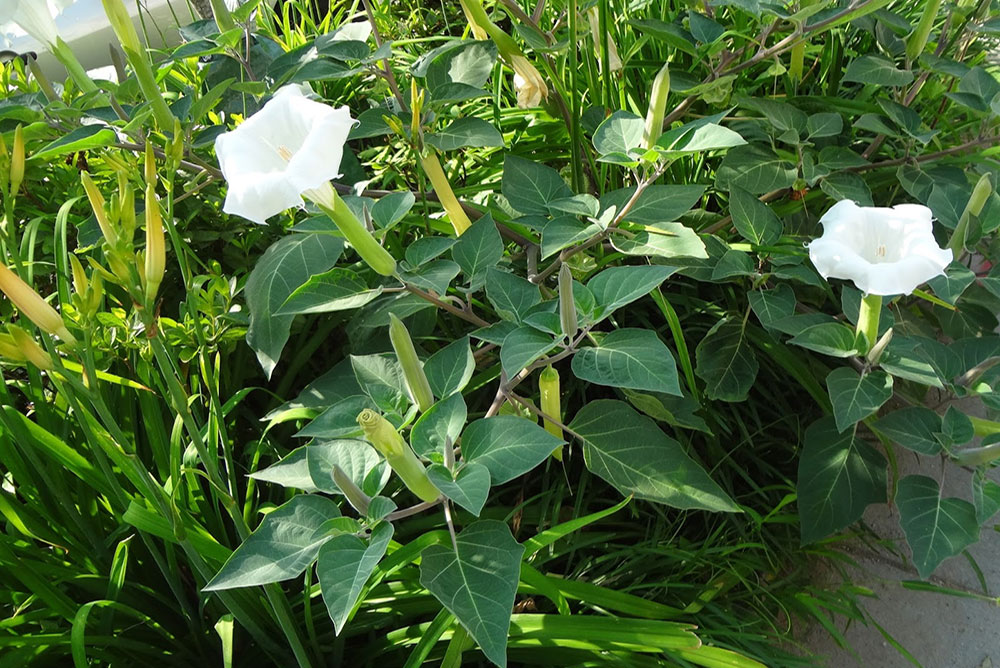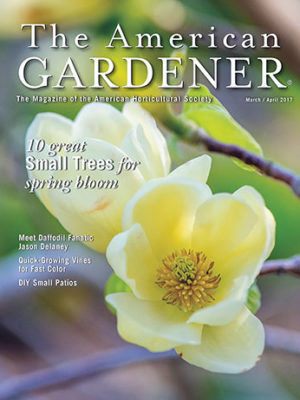
Above, a neighbor’s Datura in full flower. It’s also called Angel’s Trumpet, either because it’s so beautiful or because it’s so deadly, Datura was the poison du jour in Agatha Christie’s Sleeping Murder: Miss Marple’s Last Case. / Photo by Stephanie Cavanaugh.
I AM A NEW MEMBER of the American Horticultural Society. While this sounds impressive, it’s no big deal. Just give them $35 (or more if you’re so moved) and they send you a membership card that you can stick in your wallet. In my case, the card will immediately fall out and be ink-stained and sticky with jelly bean guts and various other substances that mysteriously lurk in the bottom of my bag, which is neither here nor there, just saying.
The Society’s website says that membership entitles you to a subscription to The American Gardener magazine, discounts at 300 public gardens throughout North America and the Cayman Islands (which I think needs explanation, if not exploration), online member resources, the annual seed exchange and special events.
 This weekend is the annual plant fair at the Society’s headquarters, River Farm in Mount Vernon, a 25-acre spread that was once part of George Washington’s estate. The sale, which will include plants and tools, is open to all from noon to 4pm on Friday (with a 10am opening for members), and 10am to 4pm on Saturday. I’m hoping The Prince can be coerced into driving me, as we’ll need to bring the truck for all the completely unnecessary plants I’ll want to buy. I do not have space for one more. . . .
This weekend is the annual plant fair at the Society’s headquarters, River Farm in Mount Vernon, a 25-acre spread that was once part of George Washington’s estate. The sale, which will include plants and tools, is open to all from noon to 4pm on Friday (with a 10am opening for members), and 10am to 4pm on Saturday. I’m hoping The Prince can be coerced into driving me, as we’ll need to bring the truck for all the completely unnecessary plants I’ll want to buy. I do not have space for one more. . . .
Meanwhile, my first issue of The American Gardener arrived yesterday. It is marked March/April and has articles on small trees and fast-growing vines, which certainly should appeal to a city gardener hungering for a little patch of shade and quick cover for a trellis or wall. While the tree tips are still handy, one finds that one should have started planting vine seeds 6 to 8 weeks before the last frost date, which happens to be April 21 around here. And not one of the wildly beautiful vines featured cares for shade, which is my garden’s most prominent attribute.
Perusing the website, between rounds of Candy Crush—I am now at level 1820 and hate to think of how much of my life has been spent getting there—I notice the section for freelance submissions to the magazine and am appalled to find myself woefully unqualified. For someone who writes about gardens, I really know nothing about nothing.
Among the “topics of particular interest” that they enjoy publishing:
Profiles of individual plant groups. I have knowledge of several, but I doubt they’d be interested in how I’ve gone wrong with them.
There are the various lilies that I planted for decades in too much shade. These, I can firmly state, will grow very tall (if they grow at all) and throw off a few flowers and then sit there cluttering a wee shade garden with their twiggish stems, which is an exceptionally boring sight. As is still the case with several other of my miscreant plants, once the flowers were spent I’d wire on “silk” lilies, which were perky all season, if scentless.
The wandering jew? Tradescantia pallid, and its ilk—some are purple, some striped with green, and so on—is so handy for filling spaces where something else has died. Stick your finger in the soil, insert a bit of stem, and water or don’t. They grow like weeds. (If you wander through a garden center, chances are you’ll find a bit of one broken off on the ground. Stick it in your pocket, break it any which way into inch-long sticks, put them in a pot and you’ll have a plant in about a week.)
Mock orange. There are, apparently, 60 varieties of this mammoth shrub, which doesn’t fruit (which is why it’s called “mock”) but does blossom in springtime with hundreds of small white flowers that one hopes smell sweet. I have found you can’t necessarily trust the grower on that last. I planted three before I found one with the honeyed memory I was seeking. Can’t tell you which it is, though, since I lost the tag.
Innovative approaches to garden design. I doubt they’d be interested in my fake flowers, amusing pots and statuary, laser lighting and other tricks I employ to obscure my failures.
Plant research. Well, this I do, and then I ignore the advice, which is why I have so many furiously invasive vines and miserably lanky climbing roses. Plant hunting is a subset of this category, and this I also do; each year buying a number of irresistible plants that I know from my research are doomed.
Plant conservation and biodiversity. My weeds grow like weeds—does that count?
Environmentally appropriate gardening. Snicker. Let us parse the term “environmentally appropriate.”
People-plant relationships (horticultural therapy, ethnobotany, community gardening). I have a relationship with my plants. It is no longer a soothing one, if it ever was. I am now thinking of a condo in Florida, where I sit on a terrace and watch the ocean, which needs no help from me. The thought of community gardening makes me itch. Spell-check does not like ethnobotony, by the way. [Stephanie: That’s cuz it’s ethnobotAny! You’re welcome.] I don’t either. Doesn’t the word have a racist reverberation? Where is this magazine published, anyway?
Plant literature and lore. Yes, well, I’m always on the lookout for literature that provides disaster-distraction tips; this seems, however, a doubtful topic for this audience. Lore? What does this even mean? How to poison your spouse, as Agatha Christie might, with a lovely datura? That, I suppose I could write about. . . .
They’re also looking for articles that illustrate useful gardening techniques such as “grafting, pollarding, or propagation.” Right.
One wonders why I write about gardens, not just once, but every week for, as of today, 50 weeks. And that’s only for Birdy here. I have been foisting my floral incompetence on whoever would have me for the last 25 or so years, and expect I’ll continue. I sure wish someone would send me to a spa in Bali or something.
Meanwhile, I’m going to Virginia this weekend and buying a plant, maybe two.
—Stephanie Cavanaugh
LittleBird Stephanie does keep writing about gardening; we just can’t stop her. To read previous columns, search for Green Acre in the Search box at the top of the screen.
